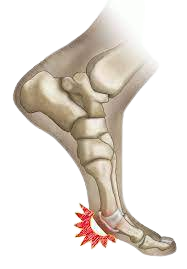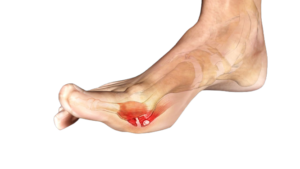What is a Turf Toe?
May 9 2023
Turf toe is an injury that affects the big toe joint. It happens when you bend your big toe too far or too forcefully. This motion causes soft tissue and ligaments in the big toe joint to stretch or tear (sprain). Ligaments are tissues that connect your bones.
Dr. Powers discusses turf toe. Symptoms, Causes, Treatment Options, and Long-term Prognosis
Turf toe is common among American football players because they frequently push off their toes into a sprint or make sudden movements while running. Most of the time, the injury gets better with treatments like rest, ice, and medications like ibuprofen or acetaminophen. Some turf toe injuries that don’t heal with these treatments may need surgical repair.
How Common is turf toe?
Turf toe is commonly associated with athletes competing on a turf surface, but it can happen to anyone. The injury can occur in various sports and activities, flexible or rigid shoe wear, and turf or flat surfaces.
Turf toe injuries increased in the 1970s when football players began playing on artificial turf instead of grass. Artificial turf is a harder surface than natural grass. There seems to be an increase in the occurrence of turf toe injuries, possibly because of the use of more flexible, lighter shoes. This also may be related to changes in the interaction of the surface with the shoe wear.
What are the symptoms of turf toe?
Turf toe symptoms range from mild to severe. If a sudden injury caused turf toe, you may have heard or felt a “pop” when the injury happened. Pain from a sudden injury usually comes on right away.
Turf toe symptoms from repetitive injuries usually appear gradually and get worse over time.
Symptoms of turf toe include:
- Pain and tenderness: Pain may be constant, or it may only hurt when you press on the area. Big toe pain may be so severe that you can’t put weight on it.
- Swelling and bruising: The base of the big toe may be inflamed. Bruising can extend around the swollen toe and up to the top of the foot.
- Limited range of motion: You may not be able to move your toe or bend it up and down. You may feel like your foot is weak or you’re unable to push off the ground like before.
- Joint that feels loose: The metatarsophalangeal (MTP) joint may pop out of place or feel like it’s unstable. The joint may also feel stiff.
What causes turf toe?
 A turf toe injury happens when the big toe is bent at a 90-degree angle and pressed flat against the ground. Usually, the heel is high off the ground, like a sprinter’s starting position. If you put too much force on the big toe, you can hyperextend it (bend it farther than it’s supposed to go). Bending the toe beyond its natural range of motion can cause ligaments, tendons, and soft tissues in the joint to stretch or tear.
A turf toe injury happens when the big toe is bent at a 90-degree angle and pressed flat against the ground. Usually, the heel is high off the ground, like a sprinter’s starting position. If you put too much force on the big toe, you can hyperextend it (bend it farther than it’s supposed to go). Bending the toe beyond its natural range of motion can cause ligaments, tendons, and soft tissues in the joint to stretch or tear.
Turf toe can result from many repetitive movements over time (like a ballet dancer’s jumps). The injury can also result from sudden trauma, such as when a football player tackles an opponent whose toe is planted on the ground.
Athletes who make sudden foot movements and changes in direction are more likely to get this type of injury.
What part of the toe does this injury affect?
The big toe has two joints. The larger joint is the MTP joint. This joint connects the base of the big toe to the rest of the foot.
Tendons, ligaments and connective tissue hold the bones and muscle of the big toe together. These structures provide stability and allow the big toe to move without dislocating. The injury can range from simple sprains to dislocations of the MTP joint.
What are the types of turf toe injuries?
Healthcare providers use a grading system to classify turf toe injuries. The grade helps determine the most effective treatment plan. The types of turf toe injuries are:
Grade 1: Typically, soft tissue is stretched, but not torn. The area is sensitive when you touch it. It may be mildly swollen. You may have mild limitations with sports and exercise abilities.
Grade 2: The soft tissue complex partially tears. The area has intense and more diffuse tenderness and is often swollen and bruised. You’ll be more limited with sports and exercises.
Grade 3: Soft tissues more completely torn. The MTP joint may be dislocated. Swelling and pain in the toe are severe. It’s very difficult to move the toe, let alone exercise or play sports.
How is turf toe diagnosed?
Your healthcare provider examines your toe and gently pushes on the area to check for tenderness. You may be asked to move your toe to test your range of motion.
To check for damage in the bones and soft tissues, your provider may order an x-ray or MRI scan. These tests produce images of bones, ligaments, tendons and soft tissues.
If you had a sudden injury, your provider will ask you how it happened. Be sure to share as many details as you can remember, including how your toe was planted and where you felt pain.
What is the treatment for turf toe?
Most sprained toe injuries heal with time and plenty of rest. Grades 1 and 2 turf toe injuries usually get better with noninvasive treatments that you can do at home. Your provider may recommend:
- Rest: Ask your provider how long you should avoid putting weight on your foot. Depending on the severity of the injury, you may need to take a break from sports and activities for several days or weeks. Your provider can give you a walking boot or crutches to use while your toe heals.
- Ice and elevation: Every few hours, relax with your foot above your heart. Apply a cold compress to your toe for about 20 minutes at a time. Ice reduces swelling and pain. Elevating your toe reduces inflammation.|
- Over-the-counter pain medication: Talk to your provider about taking nonsteroidal anti-inflammatory drugs (NSAIDs). These over-the-counter medications relieve pain and reduce swelling.
- Physical Therapy (PT): An experienced physical therapist will give you exercises and stretches to help your toe heal. A customized PT program includes exercises to reduce stiffness, improve flexibility and strengthen muscles that support the MTP joint.
- Stabilization: Ask your provider to show you how to tape your big toe to your smaller toes. This turf toe taping technique restricts motion while your toe heals. When you do return to activities, be sure to wear sturdy, supportive footwear.
- Orthotics: Your provider may recommend special inserts that fit into your shoe. Orthotics stabilize and support your toe joint while you’re running, jumping, or playing sports.
- Surgery: Rarely, a turf toe injury requires surgery to repair severe tears, fractures, or joint damage. The type of surgery depends on the injury’s location and which bones and soft tissues have the damage.Can I prevent turf toe?
You may not always be able to prevent turf toe, especially when it results from an accident. To reduce your risk of turf toe, wear shoes that provide enough stability for your activity. Football and soccer players should avoid shoes that are too flexible, especially in the toe area.
Before an activity or sport, take time to stretch and warm up. When muscles and soft tissues are warm, they’re less likely to get injured. If you play sports (such as football, gymnastics, or ballet) that increase your risk of turf toe, talk to your provider. A physical therapist can help you lower your chances of injury.
What is the long-term prognosis for people with turf toe?
Many people with turf toe do not have long-term problems after recovering from the injury. Some people continue to have joint stiffness, weakness or big toe pain (hallux rigidus). Rarely, the big toe sticks up from the others and doesn’t lie flat on the floor when standing.
When should I see my podiatrist?
 Call your podiatrist if you have pain, swelling or bruising in your toe or foot. Even if the pain is mild, it’s important to get evaluated so your provider can recommend the right treatment plan. See your podiatrist or healthcare provider right away if pain is severe, you can’t put weight on your foot or the toe joint looks dislocated.
Call your podiatrist if you have pain, swelling or bruising in your toe or foot. Even if the pain is mild, it’s important to get evaluated so your provider can recommend the right treatment plan. See your podiatrist or healthcare provider right away if pain is severe, you can’t put weight on your foot or the toe joint looks dislocated.If you are experiencing symptoms of turf toe, please contact one of our award-winning surgical podiatrists.
You can reach our office at (239) 430-3668 (FOOT) or visit www.NaplesPodiatrist.com to schedule an examination.
—————–



 Fax: (239) 692-9436
Fax: (239) 692-9436 Tel: 239-430-3668
Tel: 239-430-3668
